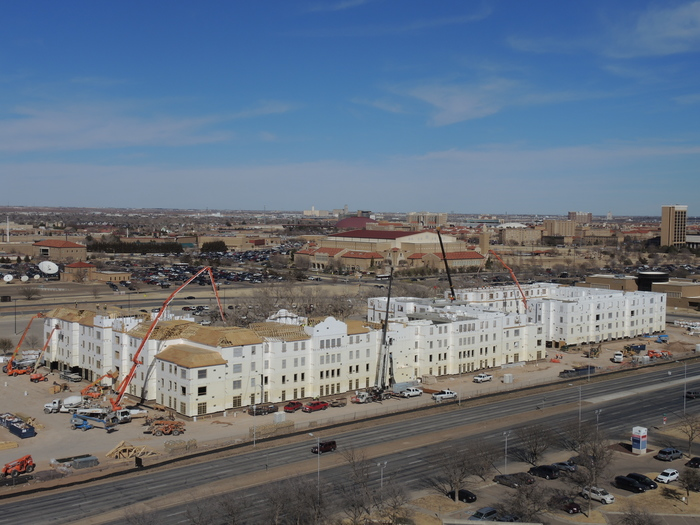
ICF vs. Steel Framing: Which Is Best For Commercial Construction?

Beginning in the 1960s, there has been an uptick in builders and architects using ICF for commercial construction in commercial construction buildings. There’s been a 30% increase in annual growth in the commercial use of insulated concrete forms, making it the most quickly expanding building system in the United States and Canada.
ICFs have been used with great success for projects such as hotels, theatres, multi-story residential, office, retail, mixed-use retail, educational projects and all manner of public works and federal military applications. However, some people argue that Steel Framing is best for commercial construction, so we decided to get to the bottom of the ICF vs. Steel Framing face-off.

Overview of Commercial Construction Materials
Insulating concrete forms (ICFs) result in cast-in-place concrete walls that are sandwiched between two tight layers of insulation material. ICF systems are strong and energy-efficient and offer a range of applications, from residential homes to commercial buildings like retails stores, hotels, and apartment complexes all the way to higher education and federal military-industrial.
The blocks are made with expanded polystyrene insulation (EPS) and they are stacked to form the shape of the walls with steel rebar strengthening the solid concrete core. Once you fill the ICF with concrete, you create a layer of continuous insulation (CI) which essentially eliminates thermal bridging through the wall.
After ICF is installed, traditional finishes are applied to both the interior and exterior faces, so the buildings look similar to your typical construction styles, but the walls are often thicker.
ICF Benefits, Cost and ROI
ICF is gaining popularity in commercial construction because it lessens labor costs, improves comfort, and provides excellent energy efficiency (it has an R-value of 23+ and exceeds ASHRAE-ANSI 90.1 energy code requirements). It boosts safety ratings and sound aesthetics over traditional building methods.
Fox Blocks ICF, with steel-reinforced concrete, is severe-wind resistant and can withstand winds of over 200 mph, including projectile debris traveling over 100 mph. It also achieves a fire-resistance rating (ASTM E119) of four hours for the six-inch blocks and eight-inch forms and two hours for the four-inch forms.
ICF is great for wet areas because Fox Blocks are durable in controlling moisture intrusion with a perm rating of below 1.0. The high thermal mass walls also absorb and store heat energy, which stabilizes temperature shifts within a building by slowing the heat transfer rate.
The entire ICF Fox Block wall system is quick, safe and incredibly fast to install because it is an all-in-one wall assembly that integrates five steps into one simple step. You get a structure, air barrier, insulation, vapor retarder and attachment all in one swift installation. This speeds up project delivery time by eliminating the need to coordinate multiple trades.
ICF can save builders money during construction and save owners money during its lifecycle. Since installation is so easy, you save money on shortening the construction schedule and give you earlier occupancy, meaning additional revenue and savings on construction loan costs.
ICF commercial buildings minimize the need for any future maintenance or repairs because they are incredibly durable and resist rot and degradation, saving you thousands of dollars in common maintenance costs required with other materials. Because of their energy efficiency and resistance to severe weather, you save even more with monthly energy expenses and in rebuilding after extreme storms.

Steel Framing Benefits, Cost and ROI
Steel is a pretty durable material while simultaneously being incredibly affordable upfront, it can serve for decades without getting damaged. It also requires less time to install versus timber material.
Steel frames may seem heavier than timber due to its density, but it is actually lighter in comparison to traditional materials. They are hollow versus being completely solid, so it’s lightweight features allow for shipping costs to be lower and for an easier build.
Steel is among the most common recyclable materials, so you can reuse them and your waste will be small. It also allows for a flexible design and adaptability in meeting your client’s needs.
Of course though, and this is important, most steel buildings only provide the exterior structure. You will need to spend extra on separate cladding and insulation, fireproofing measures and corrosion-protection methods. This adds multiple steps in your construction process and adds to the initial cost of your “affordable” steel frames.
Materials Face-Off
When deciding on a material to utilize for your next project, you need to consider the hard costs, the soft costs, the long-term costs and the financial costs associated with each material.
Hard costs consist of labor, materials, construction equipment, landscaping, utilities, life safety systems, paving, LEED certification, grading and HVAC systems. When comparing hard costs, ICF is the clear winner. You save immensely in lessened labor, construction equipment, HVAC systems and utilities.
Soft costs include permitting, insurance, architectural design, legal fees, moveable furniture and equipment, engineering, taxes and any other charges that aren’t related to actual brick-and-mortar costs. We would say you are pretty equivalent in soft costs between ICF and Steel Framing.
In long-term cost consideration, you need to think about utility, maintenance, indoor environmental quality features, and any other daily, weekly and monthly expenses after installation. Steel is usually cheaper upfront, but in the long-term, you are going to be paying so much more to take care of steel-framed buildings.
Financial costs include the borrowing expenses associated with obtaining a construction loan. With ICF’s easy and quick, all-in-one installation, you are on-site for a lesser amount of time, lowering your borrowing expenses. ICF is the clear winner.
The cost of ICF versus steel framing is typically more for the actual construction, but the cost of ownership of an ICF structure is significantly less. In nearly every documented case of the cost of an ICF structure, the return on investment (ROI) for the extra construction cost is within 5 years, with many hitting a return within 3 years.

Want to learn more about ICF and how it can be a solution for your next project? Check out Fox Blocks’ offer and to contact us.